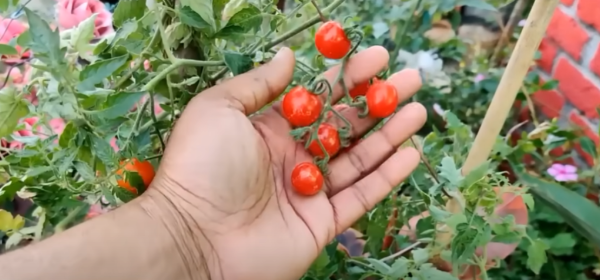Septoria leaf spot, a common fungal disease, poses significant challenges for tomato growers worldwide. This comprehensive guide will deepen your understanding of the disease, its lifecycle, and its impact on the health of tomato plants.
Importantly, we will delve into the primary question – is it safe to consume tomatoes affected by Septoria leaf spot? We will explore preventative measures and treatment options for infected plants.
This resource aims to assist you in gaining mastery of the topic and making informed decisions about the consumption and cultivation of tomatoes in the presence of Septoria leaf spot.
Key Features
- Septoria leaf spot does not make tomatoes inedible or toxic.
- Spotted tomatoes may not be visually appealing and could potentially affect the taste of the fruit.
- Infected tomatoes tend to be lighter due to water loss and have a reduced shelf life.
- Properly identifying and handling spotted tomatoes, including removing blemished skin before culinary use, can minimise risks.
Try to understanding Septoria Leaf Spot
Septoria Leaf Spot, a common fungal disease, affects a significant number of tomato plants worldwide, thereby necessitating a comprehensive understanding of its symptoms, causes, and management. The disease originates from Septoria lycopersici, a pathogenic fungus with unique characteristics.
This pathogen primarily affects solanaceous crops, particularly tomatoes, and possesses an exceptional ability to overwinter in crop residues. Its microscopic, elliptical conidia are disseminated by wind and rain splashes, making disease management a challenging task. The fungus also demonstrates a high degree of genetic variability, enhancing its adaptability to environmental changes and resistance to fungicides.
Understanding the disease origin and the pathogen characteristics is pivotal in devising effective control measures. This understanding will also aid in identifying Septoria Leaf Spot symptoms, the focus of the next section.
Identifying Septoria Leaf Spot Symptoms
Typically, early identification of Septoria Leaf Spot symptoms is crucial in managing the disease and minimising its potential impact on tomato harvests. Notably, understanding leaf spot causes enhances the selection of spot resistant varieties.
The following symptoms are indicative of Septoria Leaf Spot:
- Small, water-soaked spots appearing on lower leaves after the first fruit sets.
- Spots enlarging into circular, greyish-white lesions with dark edges.
- Yellowing and withering of infected leaves, starting from the bottom and spreading upwards.
- Tiny, black fruiting structures known as pycnidia appearing in the centre of lesions.
- Severe defoliation, potentially leading to sunscald on the exposed fruit.
Timely identification of these symptoms allows for adequate interventions, thereby ensuring a healthy, bountiful harvest.
The Life Cycle of Septoria Leaf Spot
To understand the implications of Septoria Leaf Spot on tomato consumption, a comprehensive understanding of its lifecycle is necessary. This includes an investigation into the initial infection stages, a detailed timeline of disease progression, and its subsequent effects on tomato yield.
This lifecycle analysis will provide insight into the severity and longevity of the disease, and its overall impact on tomato crop health.
Initial Infection Stages
Understanding the life cycle of Septoria Leaf Spot, particularly its initial infection stages, is crucial to effectively manage and control this common tomato disease.
- The Septoria pathogen primarily survives in plant debris and soil, marking them as significant infection sources.
- Upon favourable environmental conditions, these sources release spores that infect the tomato plant.
- The leaves, being the most susceptible part, become the initial site of infection.
- The disease progresses rapidly, causing significant damage if left untreated.
- Resistance breeding, which involves developing tomato varieties that are naturally resistant to Septoria, is a promising avenue of control.
Understanding these stages provides a roadmap for preventing or controlling Septoria Leaf Spot, enabling healthier, more productive tomato plants.
Disease Progression Timeline
Following the initial infection stages, the life cycle of Septoria Leaf Spot progresses in a distinct timeline that further impacts the health of the tomato plant.
The disease spread begins with fungal spores landing on the tomato leaves, typically during periods of wet weather.
Over the course of 7-12 days, the spores germinate and penetrate the leaf tissue, leading to the formation of visible spots. This is a critical point in the disease’s lifecycle, as it marks the beginning of fungal reproduction.
The fungus then produces pycnidia, structures filled with new spores, within these spots.
When splashed by water, these spores are dispersed, initiating a new cycle of infection.
This progression underlines the persistent and damaging nature of Septoria Leaf Spot.
Impact on Tomato Yield
The persistent and damaging nature of Septoria Leaf Spot significantly affects the yield of tomato crops, with the disease’s lifecycle playing a crucial role in this impact.
Septoria Leaf Spot begins as small water-soaked spots on the lower leaves. These spots enlarge and develop a greyish-white centre with a dark edge.
The disease progresses upwards, eventually infecting the entire plant and leading to yield reduction.
Warm, wet weather conditions accelerate the disease’s lifecycle, exacerbating its impact on tomato yield. The fungus overwinters on infected plant debris and seeds, causing recurring infections and challenging disease resilience.
Effective management strategies can mitigate the disease’s impact, but complete eradication is currently unachievable.
Understanding this lifecycle is crucial in developing strategies to improve crop yield and disease resilience. Want to know more? Check out our helpful resources: Tomato Mentor
Impact on Tomato Plant Health
Septoria leaf spot, a common fungal disease, poses significant threats to the overall health and productivity of tomato plants. This pathogen impairs the tomato nutrition impact by inhibiting photosynthesis, thus disrupting the plant’s ability to generate vital nutrients.
Moreover, the disease’s relentless progression potentially reduces leaf spot resistance, weakening the plant’s innate defence mechanisms. The fungus directly attacks the plant’s foliage, creating numerous small, circular spots that eventually coalesce, leading to extensive leaf necrosis. This process not only hampers the plant’s growth but also compromises the quality and yield of the fruit.
Therefore, managing Septoria leaf spot is crucial not just for maintaining tomato plant health but also for ensuring the production of high-quality, nutritious tomatoes.
Does Septoria Leaf Spot Affect Edibility
In terms of edibility, it’s crucial to note that Septoria leaf spot does not render tomatoes inedible or toxic; however, it can significantly impact the fruit’s quality. The edible implications include:
- Aesthetic deterioration: Spotted tomatoes may not be visually appealing.
- Flavour alteration: The disease could potentially affect the taste of the fruit.
- Weight loss: Infected tomatoes tend to be lighter due to loss of water content.
- Shorter shelf life: The disease accelerates the ripening process, reducing the fruit’s longevity.
- Cooking methods: Blemished skin may require removal before culinary use.
To summarise, while Septoria leaf spot does not directly affect the edibility of tomatoes, it can compromise their quality and culinary utility.
The following section would delve into the safe consumption of spotted tomatoes.
Safe Consumption of Spotted Tomatoes
In order to ensure the safe consumption of tomatoes affected by Septoria leaf spot, it is crucial to accurately identify the symptoms on the fruit.
A comprehensive health risk assessment, examining potential hazards linked to the ingestion of these tomatoes, must be carried out.
This will provide key insights into the impact of Septoria leaf spot on the edibility of tomatoes.
Identifying Spotted Tomatoes
Identifying spotted tomatoes, particularly those affected by Septoria Leaf Spot, is crucial for safe consumption and ensuring the overall health of your garden. Tomato discoloration is the primary visual indicator; look for yellow spots that eventually turn brown. Spot patterns are also important, as Septoria Leaf Spot typically manifests in clusters.
When identifying, consider:
- The stage of the tomato: Septoria often affects mature tomatoes.
- The pattern of discoloration: Septoria creates irregular, clustered patterns.
- The progression of the spots: They start yellow and darken over time.
- The location of the spots: They usually start on the lower leaves.
- The overall plant health: Affected plants may exhibit stunted growth.
Understanding these signs prepares us for the subsequent section, ‘health risks assessment’.
Health Risks Assessment
It’s essential for your health to evaluate the safety of consuming tomatoes affected by Septoria Leaf Spot. While the fungus primarily targets the foliage, it doesn’t typically influence the fruit’s edibility. However, dietary implications should be considered.
The decayed leaves may harbour other pathogens, and while not directly harmful, these can negatively impact the taste and quality of the tomato. In addition, there are cross-contamination risks. The spores of the fungus can easily spread to other fruits, vegetables, and surfaces in your kitchen, potentially leading to a wider infestation. Therefore, while the direct health risks are minimal, the indirect implications warrant caution.
In the following section, we will delve into effective strategies for preventing Septoria Leaf Spot.
Preventing Septoria Leaf Spot
Before the onset of Septoria leaf spot, implementing preventative measures is crucial to maintaining the health and productivity of your tomato plants. A combination of cultural control methods and resistant varieties selection is key in preventing this disease.
Cultural control methods: This involves practices such as crop rotation, sanitation, and maintaining proper spacing between plants to improve air circulation.
Resistant varieties selection: Choosing tomato varieties that are resistant to Septoria leaf spot reduces the likelihood of disease occurrence.
Regular inspection: Early detection plays a major role in disease management.
Use of fungicides: These can be applied as part of an integrated pest management strategy.
Proper watering techniques: Avoid watering from above which can splash spores onto leaves.
In the event of infection, several treatment options for infected plants are available, which we will discuss next.
Treatment Options for Infected Plants
Even though preventative measures can significantly reduce the likelihood of Septoria leaf spot infection, it’s important to know the various treatment options available should your tomato plants become infected.
Organic remedies, such as neem oil and baking soda solutions, can be applied to affected plants to hinder fungal growth. These act by altering the plant’s pH, creating an inhospitable environment for the pathogen.
Alternatively, fungicide applications can be employed. Fungicides containing chlorothalonil or copper are most effective against Septoria leaf spot. These chemical agents disrupt essential processes within the fungal cells, thereby preventing their proliferation.
Regardless of the chosen method, it’s crucial to maintain regular treatments until the infection is fully controlled.
Frequently Asked Questions
Can Septoria Leaf Spot Be Transferred to Other Types of Plants?
Yes, Septoria leaf spot can be transferred to other plants. Disease prevention is crucial to limit cross contamination risks. Regular inspection, appropriate spacing, and sanitation practices can help manage this fungal disease’s spread.
What Other Vegetables or Fruits Are Susceptible to Septoria Leaf Spot?
Numerous fruits and vegetables, including cucurbits and solanaceous crops, are susceptible to Septoria leaf spot. The impact on harvest yield can be significant without Septoria resistance breeding, often necessitating rigorous plant disease management strategies.
How Can I Tell the Difference Between Septoria Leaf Spot and Other Similar Plant Diseases?
Identifying Septoria symptoms involves observing telltale circular spots on leaves. Unlike other plant diseases, Septoria leaf spot features grey centres and dark edges. Leaf Spot Management includes regular fungicide application and proper sanitation.
Are There Any Natural Remedies or Organic Treatments for Septoria Leaf Spot?
Preventive measures are the best medicine against Septoria leaf spot. Enhancing disease resistance through crop rotation, sanitation, and organic fungicides like copper or sulphur spray are proven strategies to naturally combat this disease.
Can Septoria Leaf Spot Survive in the Soil During Winter or Off-Season?
Septoria leaf spot can indeed survive in soil during winter or off-season utilising winter survival strategies such as overwintering in plant debris. Off-season maintenance, including thorough cleanup, is crucial to control its spread.
Conclusion
In conclusion, Septoria leaf spot doesn’t affect the edibility of tomatoes, though it can degrade the plant’s overall health.
Ensuring a safe consumption involves proper washing and inspection.
Maintaining healthy gardening practices and employing effective treatments can mitigate the disease’s impact.
As the adage goes, ‘an ounce of prevention is worth a pound of cure’, which is particularly true in preventing and treating Septoria leaf spot in tomato plants.






